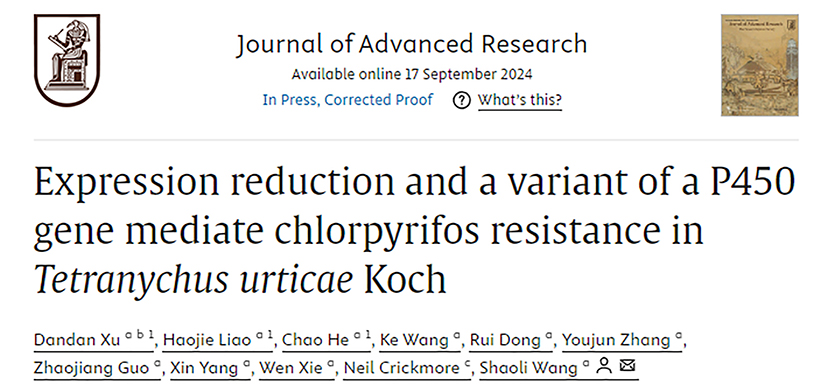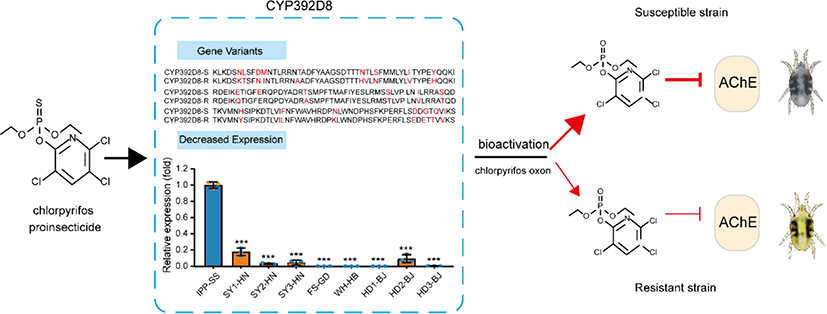Recently, researchers from Institute of Vegetables and Flowers (IVF), Chinese Academy of Agricultural Sciences (CAAS), reported their study results entitled “Expression reduction and a variant of a P450 gene mediate chlorpyrifos resistance in Tetranychus urticae Koch” in Journal of Advanced Research (IF=11.4, Q1). This work highlights the role of a cytochrome P450, particularly CYP392D8, in the development of chlorpyrifos resistance in the two-spotted spider mite. This study provides new insights into the molecular mechanisms underlying the resistance of the two-spotted spider mite to organophosphate pesticides, offering significant theoretical implications for the management of pesticide resistance of pest mites in the field.

The two-spotted spider mite, Tetranychus urticae, as a major agricultural pest worldwide, can infest more than 1,200 host plants including vegetables, fruit trees, strawberries, cucurbits, and legumes etc. Chemical pesticides are commonly used in the integrated management of this mite; however, prolonged exposure to these pesticides has led to varying degrees of resistance in T. urticae against different insecticides. Resistance monitoring in previous studies showed that the different T. urtciae populations in China developed high-level resistance to chlorpyrifos, but the resistance mechanism remains unclear.
In this study, researchers first detected that no obvious positive correlation existed between the resistance levels to chlorpyrifos and mutation frequency of the target acetylcholinesterase gene ACHE. Then, they found that a P450 gene CYP392D8 was significantly down-regulated in chlorpyrifos-resistant populations, and the recombinant protein could activate chlorpyrifos to produce a more toxic compound, chlorpyrifos-oxon, in vitro. After T. urticae mites were exposed to low doses of chlorpyrifos, they observed significantly more chlorpyrifos-oxon produced in the susceptible populations, exhibiting higher inhibition rate of acetylcholinesterase (AChE) in the susceptible populations compared to the resistant ones. Additionally, the researchers found that only the susceptible genotype (CYP392D8-S) of the CYP392D8 gene exists in the susceptible populations, while both susceptible (CYP392D8-S) and resistant (CYP392D8-R) genotypes coexist in the resistant populations at different proportions, with the susceptible genotype having a stronger metabolic capacity for chlorpyrifos than the resistant genotype.
This study indicates that the decreased expression of CYP392D8 reduces the bioactivation of chlorpyrifos into the more toxic chlorpyrifos-oxon, and the presence of sequence variants of CYP392D8 further diminishes this ability, leading to the development of chlorpyrifos resistance in T. urticae field populations.

Figure 1. Chlorpyrifos resistance mediated by the reduced expression and variants of the CYP392D8 gene in T. urticae
The research was supported by the National Natural Science Foundation of China, the National Key R&D Program of China, the Beijing Agriculture Innovation Consortium and the Science and Technology Innovation Program of the Chinese Academy of Agricultural Sciences.
More information can be found through the link: https://doi.org/10.1016/j.jare.2024.09.015